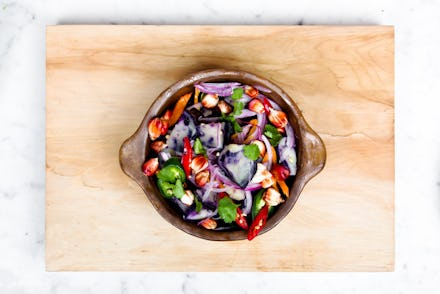5 Ways to Eat Healthy That Don't Involve a Tasteless Salad or a Chalky Shake

What's disappointing about salad: Eating it is rarely as fun or silly or encouraging of hearty laughter as healthful living ads would have us believe. And many people would agree that the only enjoyable kind of consumable shake is a milkshake — protein shakes and their nutrient-boosting equivalents often come with a creepy, chalky mouthfeel and a chemical flavor profile.
But how does one eat healthy — get all the recommended vitamins, minerals, etc. — without ingesting a daily medley of greens or downing the occasional chalky nutritional beverage?
Read more: How to Eat Healthy Without Being Hungry All the Time
Strategies abound, but the one we recommend is variety and forethought: incorporating the below food varieties into a daily routine and having healthy snacks at the ready will help develop the positive eating habits, without the monotony of salads and unsatisfying nutrition shakes (an oxymoron, let's be real).
1. Sorry, but you still have to eat vegetables.
But how you eat them is entirely up to you. The President's Council on Fitness, Sports and Nutrition recommends filling one half of one's plate with orange, red and dark-green vegetables at every meal.
That may be a tall order for readers who were subsisting on salads because the intimidating volume of veggies nutritional experts would have us eat is unrealistic for their daily feeding habits; for those readers, we hear you and we suggest jamming that half-plate of vegetables into a blender or juicer, rendering the portion portable.
Now the vegetables can come with you as you commute, or while you work through your to-do list on the job. Just be sure to treat the juice concoction as a supplement and not a replacement — juice diets aren't good for you. And whatever the form the veggies take, creativity in preparation is encouraged so as to avoid the salad trap.
2. Stick to lean proteins.
The President's Council also advises that lean protein is a key component of a healthy diet. Chicken, turkey and fish are obvious choices there, but they're not the only ones: dry peas and beans, nuts, seeds and eggs are also good protein sources.
Lean cuts of beef — as in, sirloin, tenderloin and top round — are also advisable because they're filling, according to Health magazine. The caveat: Red meat, especially when processed, has been associated with an escalated risk of cancer and cardiovascular disease. All steak in moderation.
3. Cut sugar consumption.
As the entire world knows by now, sugar is terrible for you. And yet, it is so good — which is why, according to the Harvard Health Blog, added sugar comprises 10% of the average person's daily caloric intake. Unfortunately, that added sugar may be killing us. But how to cut down when sugar is in so many products?
Avoiding processed foods is a good place to start. Instead of the fruit-and-nut bar, have the fruit — which contains natural sugar, fructose — and the nuts in their raw form. Berries are among the fruits with lower sugar content and because they're also packed with antioxidants, fiber and vitamins, they're among the healthiest foods in the produce aisle.
People who love and will miss chocolate will perhaps be mollified in their feelings of disappointment by the reminder that cacao nibs, from which chocolate is made, are a low-sugar relative of and possible replacement for the treat. They offer antioxidants, flavonoids, fiber, magnesium and potassium along with other potential health perks, while satisfying those chocolate cravings.
4. Eat healthy and filling fats.
Avocados are another fruit (that's right) that's low in sugar, high in an alphabet of vitamins, high in fiber and in antioxidants. They're also high in fat, but the good kind of fat that holds benefits for the heart and, according to Health, keeps you feeling full.
Another option in this category is the almond: Whether raw or roasted or milk, almonds boast a similar nutrient profile and are a more satiating snack than, say, a banana or some carrot sticks. An almond milk caution: Opt for unsweetened, as regular almond milk often contains a large amount of sugar.
5. Be prepared.
Which means both preparing food ahead of time, and preparing yourself for snacking situations by keeping it on your person. There's no need to bust out the mortar and pestle per the above photo, but bringing a homemade lunch to work — the leftovers from a healthy meal or a five-ingredients-or-fewer option you can quickly make yourself — and incorporating the above food items into the dishes you prepare will lead to healthier eating habits.
As will packing them as snacks for the office and for when you're on the move. Bringing along a bag of almonds, or fruits, or vegetable sticks with homemade dip (say, hummus) can mean fewer vending machine purchases and a lower total of chips consumed per day. Stash them for later and avoid impulse buying prepackaged, processed snacks.